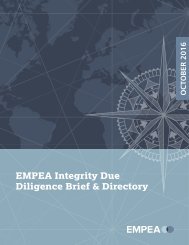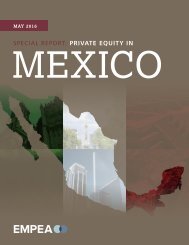You also want an ePaper? Increase the reach of your titles
YUMPU automatically turns print PDFs into web optimized ePapers that Google loves.
• Good accessibility. Good communications both<br />
international transit (including visa and immigration<br />
processes) and telecommunications are important.<br />
• Locational appeal. Good and affordable<br />
infrastructure, accommodation, schooling and<br />
assured personal safety.<br />
However, while all the<br />
above factors are necessary<br />
conditions for replicating the<br />
comparative advantages<br />
associated with an <strong>of</strong>fshore<br />
centre, it is doubtful whether<br />
they are sufficient. Successful<br />
international financial centres<br />
around the globe—whether<br />
London, Hong Kong, Singapore<br />
or Switzerland—were<br />
not created in isolation, but<br />
arose in conjunction with<br />
development <strong>of</strong> a vibrant<br />
domestic financial services<br />
industry.<br />
Figure 3: Ownership linkages among African banks<br />
Looking beyond the issue <strong>of</strong><br />
scale, experience suggests<br />
that the political economy <strong>of</strong><br />
financial sector reform is an<br />
uncertain process, particularly<br />
when such reforms entail<br />
provision <strong>of</strong> public goods,<br />
such as a conducive legal<br />
and regulatory framework,<br />
strong judicial and oversight processes, efficient financial<br />
infrastructure, etc. Local private sector parties most<br />
impacted by shortfalls in current systems are likely to<br />
be the most vocal and effective drivers <strong>of</strong> such reform<br />
processes. Thus, rather than engage directly in dialogue<br />
with authorities on the reform process, the most impactful<br />
approach to supporting improvement may well be to build<br />
on the influence <strong>of</strong> those local private sector parties most<br />
impacted by current circumstances (such as PE fund<br />
managers whose activities are hampered by shortfalls in<br />
the enabling environment). They are likely to be the most<br />
effective drivers <strong>of</strong> such reform processes, see Box 2.<br />
Note: The graph only shows ownership linkages between countries if the<br />
share <strong>of</strong> assets held by home countries constitutes at least 10% <strong>of</strong> the<br />
host country’s banking system. The size <strong>of</strong> the bubbles is in proportion to<br />
the absolute size <strong>of</strong> each country’s banking sector. The reference year is<br />
2011; where 2011 data was not available, figures from 2009-2012 were<br />
used instead. Sources: Central Bank websites, annual reports <strong>of</strong> banking<br />
groups, Claessens and van Horen Bank Ownership Database, World Bank<br />
/ IMF country reports, GIZ (2012a, 2012b, 2012c, 2012d).<br />
Judging the prospects for onshoring in Africa in relation to<br />
the prospective depth <strong>of</strong> the local financial services sector<br />
is important, as African financial systems are significantly<br />
burdened by fragmentation. While not precluding small<br />
countries from becoming financial centres, their ability<br />
to assume this role depends on harvesting economies <strong>of</strong><br />
scale and could be significantly handicapped unless they<br />
provide a ‘gateway’ to a<br />
financial sector <strong>of</strong> significant<br />
depth—e.g., as part <strong>of</strong> a<br />
currency union or a financial<br />
services free-trade zone. A<br />
small country that cannot<br />
provide such a ‘hinterland’<br />
will find it much more difficult<br />
to compete with <strong>of</strong>fshore<br />
centres, such as Mauritius.<br />
In setting up a locally-based<br />
financial services centre<br />
providing access to an<br />
investor base <strong>of</strong> significant<br />
size will be an important<br />
factor in determining the<br />
‘viability’ <strong>of</strong> undertaking the<br />
required institutional and<br />
infrastructure investments.<br />
Another important consideration<br />
is whether countries<br />
already aspire to becoming<br />
sub-regional hubs for financial<br />
services as reflected<br />
by the investments made<br />
by their financial systems in neighboring countries and<br />
their capacity—both human resources and technical—<br />
to expand their presence from their home base. A recent<br />
study 12 maps the increasingly important role <strong>of</strong> South-<br />
South investment in African banking, see Figure 3<br />
above. While South Africa still has a dominant position in<br />
cross-border banking in Africa, the study documents the<br />
increasing importance <strong>of</strong> Kenya, Nigeria and Morocco as<br />
sub-regional hubs.<br />
Given the East African Community common market and<br />
increasing liberalization <strong>of</strong> capital movements within the<br />
Community, Nairobi has developed a vision <strong>of</strong> becoming<br />
12<br />
Thorsten Beck, Michael Fuchs, Makaio Witte and Dorothe Singer, Making Cross-Border Banking World for Africa, June 2014, published by GIZ, the World<br />
Bank the African Association <strong>of</strong> Central Bankers and the Making Finance Work for Africa partnership.<br />
<strong>Conduits</strong> <strong>of</strong> <strong>Capital</strong> – Onshore Financial Centres and Their Relevance to African Private Equity<br />
| 91





